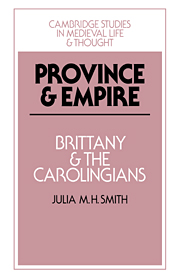Book contents
- Frontmatter
- Contents
- List of illustrations
- Acknowledgements
- List of abbreviations
- Note on nomenclature
- 1 Neustria, Brittany, and northern Aquitaine
- 2 Redon and environs
- Introduction
- 1 Settlement and society in dark age Brittany
- 2 Neustria and the Breton march
- 3 The Bretons in the Christian empire of Louis the Pious
- 4 Carolingian hegemony and Breton revolts, 840–874
- 5 An anatomy of power
- 6 Churches and learning in Carolingian Brittany
- 7 The end of Carolingian Brittany
- List of manuscripts cited
- Bibliography
- Index
- Cambridge studies in medieval life and thought Fourth series
2 - Neustria and the Breton march
Published online by Cambridge University Press: 26 October 2009
- Frontmatter
- Contents
- List of illustrations
- Acknowledgements
- List of abbreviations
- Note on nomenclature
- 1 Neustria, Brittany, and northern Aquitaine
- 2 Redon and environs
- Introduction
- 1 Settlement and society in dark age Brittany
- 2 Neustria and the Breton march
- 3 The Bretons in the Christian empire of Louis the Pious
- 4 Carolingian hegemony and Breton revolts, 840–874
- 5 An anatomy of power
- 6 Churches and learning in Carolingian Brittany
- 7 The end of Carolingian Brittany
- List of manuscripts cited
- Bibliography
- Index
- Cambridge studies in medieval life and thought Fourth series
Summary
Of all the kingdoms which emerged from the wreckage of the western Roman empire, that of the Franks was the most successful and the most enduring. However, neither Merovingians nor Carolingians ruled a homogeneous society. The heart of their kingdom was the Roman province of Gaul, where centuries of Roman rule had established administrative conventions and provided the environment within which Christian worship had spread, above all in urban areas. This large and rich province was unevenly Romanised, and everywhere ancient traditions of agricultural exploitation were adjusted to the local climate and relief. The collapse of the pax Romana induced dislocations in trade, settlement patterns, and land use, and the uneven distribution of immigrants of various Germanic peoples strengthened the regional diversities of early medieval Gaul and helped forge new ethnic identities within it.
Over this rich and variegated kingdom, Merovingian rule ebbed and flowed. Dynastic infighting, the competence or incompetence of individual kings, the lure of resources to be won beyond the frontiers all played their part in shaping the ever-fluid geography of power and authority. The sea-bed over which this tide washed was at some times accepting, at others resistant. Entrenched regional interests – churches, cities, aristocratic families – set up eddies, but more often grew by accretion than decayed through attrition. Relicts of Roman administrative machinery gradually corroded and crumbled in this changed environment.
- Type
- Chapter
- Information
- Province and EmpireBrittany and the Carolingians, pp. 33 - 59Publisher: Cambridge University PressPrint publication year: 1992

